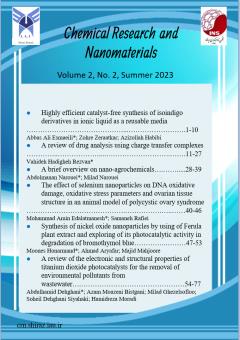Optimization of gel formulation containing CMC, HPMC, and PVA enhanced cosmetic, hygiene, and pharmaceutical applications using central composite design (CCD)
Subject Areas : Polymers and Organic Structures
Rezvan Ahmadi pour
1
![]() ,
Farzaneh Ebrahimzadeh
2
*
,
Farzaneh Ebrahimzadeh
2
*
![]()
1 - Department of Chemistry, Fasa Branch, Islamic Azad University, Fasa, Iran
2 - Department of Chemistry Marvdasht Branch, Islamic Azad University, Marvdasht, Iran
Keywords: Carboxymethyl cellulose (CMC), Hydroxypropyl methylcellulose (HPMC), polyvinyl alcohol (PVA), Polymer gels, Viscosity stability,
Abstract :
In this study, the characteristics of gels produced from polymers including carboxymethyl cellulose (CMC), hydroxypropyl methylcellulose (HPMC), and polyvinyl alcohol (PVA) were investigated as functions of transparency preservation, pH, and viscosity retention over a period of 60 days. The investigation was conducted using Design Expert software and by employing a design of experiments based on a Central Composite Design (CCD) model. Changes in the weight ratio of the gel producer's implementation are considered the independent variable, while variations in pH, transparency, and viscosity changes of the produced gels over a 60-day period are recognized as the dependent variables. The variations in viscosity over the course of 60 days, at time intervals of 1, 7, 14, 28, and 60 days, for CMC, HPMC, and PVA individually, indicate that without the presence of a cross-linking agent, viscosity undergoes changes over time. Through a detailed analysis of the results obtained from 16 designed experiments, the optimal gel formulation, which ensures the preservation of structure, transparency, and pH within the neutral range, as well as the retention of viscosity over time, was predicted. This optimal formulation consists of a weight ratio of 9.68% CMC, 1.27% HPMC, and 4% PVA.
1. M. Chelu, A. M. Musuc, Gels 9, 161(2023).
2. A. K. Nayak, B. Das, Polymeric gels, Elsevier2018.
3. Y. Jiang. L. Liu. B. Wang. X. Yang. Z. Chen. Y. Zhong. L. Zhang. Z. Mao. H. Xu, X. Sui, Food Hydrocoll. 91, 232 (2019).
4. D. E. Ciolacu. R. Nicu, F. Ciolacu, Materials 13, 5270(2020).
5. M. Davidovich-Pinhas. A. J. Gravelle. S. Barbut, A. G. Marangoni, Food Hydrocoll. 46, 76 (2015).
6. D. E. Ciolacu, Cellulose-Based Superabsorbent Hydrogels. (2018) Polymers and Polymeric Composites: A Reference Series; Mondal, M., Ed, 65
7. B. Jeong. S. W. Kim, Y. H. Bae, Adv. Drug Deliv. Rev. 64, 154(2012).
8. S. H. Zainal. N. H. Mohd. N. Suhaili. F. H. Anuar. A. M. Lazim, R. Othaman, J. Mater. Res. Technol. 10, 935(2021).
9. A. Shawesh. S. Kallioinen. O. Antikainen, J. Yliruusi, Die Pharmazie 57 (2002) 690.
10. J. Ma. X. Li, Y. Bao, RSC adv. 5, 59745(2015).
11. S. M. Silva. F. V. Pinto. F. E. Antunes. M. G. Miguel. J. J. Sousa, A. A. Pais, J. Colloid Interface Sci. 327, 333(2008).
12. R. Bodvik. A. Dedinaite. L. Karlson. M. Bergström. P. Bäverbäck. J. S. Pedersen. K. Edwards. G. Karlsson. I. Varga, P. M. Claesson, Colloids Surf. A: Physicochem. Eng. 354, 162(2010).
13. M. Wang. J. Bai. K. Shao. W. Tang. X. Zhao. D. Lin. S. Huang. C. Chen. Z. Ding, J. Ye, Int. J. Polym. Sci. 2021,1(2021).
14. G. d. J. C. Fernandes. P. H. Campelo. J. de Abreu Figueiredo. H. J. Barbosa de Souza. M. R. S. Peixoto Joele. M. I. Yoshida, L. d. F. Henriques Lourenço, Sci. Rep. 12, 10497(2022).

